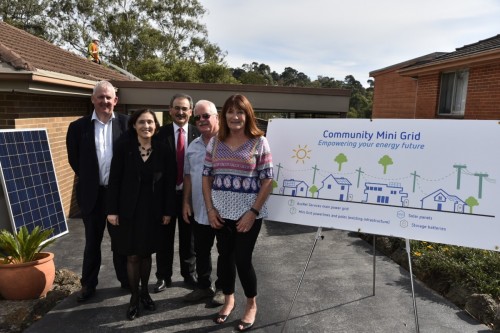What is a microgrid? Depends who you ask.
The term ‘microgrid’ can mean many different things. Indeed, in researching this article it was the first question asked by those approached – “What do you mean by microgrid?”
The Rocky Mountain Institute, the Colorado-based research foundation focussed on energy and resource efficiency, suggests asking 10 questions to understand what kind of microgrid we’re talking about.[1]
Questions include: What size is it? What is its purpose? What load does it cover? How long can it provide power? Does it share infrastructure, and interact with, the grid?
Size can be defined by generation capacity, peak load, customers served, or geographical coverage. There are picogrids, nanogrids, microgrids and macrogrids. Some question whether a standalone system is a microgrid or just a smaller grid – a minigrid or remote grid.
Microgrids may utilise existing grid infrastructure or be physically separate from the grid. The dynamic exchange of services and value within a microgrid, and across the points of interconnection between a microgrid and the main grid, vary.
Microgrids in Australia
Australian energy networks are operating ‘microgrids’ of all shapes and sizes for the benefit of customers and the network.
AusNet Services last month launched Australia’s first mini grid trial in an established community in the Melbourne suburb of Mooroolbark, partnering with the community to demonstrate that homes with residential solar systems and batteries can generate, store and share renewable electricity with each other as a ‘minigrid’ via their local powerlines and support the electricity network.

Photo: Lily D’Ambrosio (Victorian Energy Minister) launches the Mooroolbark Mini Grid Project with Alistair Parker (GM, Asset Management, AusNet Services) and Nino Ficca (MD, AusNet Services) along with trial participants Ian and Sun McDonald.
Western Power will contribute to a feasibility study investigating development of an ‘edge-of-grid’ microgrid solution, aimed at improving reliability of the 140 kilometre network between Geraldton and Kalbarri and support the Kalbarri community in Western Australia’s mid-west region. The smart system would be able to reverse power flows overnight when stored energy was insufficient to meet demand and disconnect from the larger network should a fault occur.
Also, Western Power, with Carnegie Wave Energy, will trial on Garden Island the first microgrid project in the world that combines wave energy, solar (photovoltaic) energy, a desalination plant and energy storage, and connects to a large electricity network, with Western Power seeing significant potential for long-term economic benefits in increasing the amount of decentralised energy generation located near the edges of the grid.
Ergon Energy’s 264 kilowatt solar farm at remote Doomadgee in north-west Queensland chalked up its second birthday recently. Ergon’s engineers successfully integrated large-scale solar with the isolated township’s existing diesel generation power station to provide a solution that delivers reliable and renewable power, and reduces reliance on diesel fuel by about 115,000 litres each year. The system services 1052 people in one of the larger of 39 isolated communities serviced by Ergon.
Horizon Power also services isolated communities including the towns of Sandstone and Carnarvon. Sandstone, located approximately 660 kilometres north-east of Perth, is supported by Horizon with an isolated power system – an 11kV distribution network and a peak load of 180kW. The microgrid has 34kW of solar PV installed by customers and Horizon purchases power – a contracted maximum demand of 192kW – from an Independent Power Producer with an installed generation capacity of 456kW.
Carnarvon, approximately 900 kilometres north of Perth, has a service area of about 300 square kms. Horizon supplies power to 6500 customers connected to a network of 520kms of powerlines and 8600 power poles. In addition to operation and maintenance of the distribution system, Horizon Power operates two power stations with a total firm capacity of about 15MW. The network includes 120 customers with a total installed solar PV capacity of about 1.2MW.
The designs proven in the King Island Renewable Energy Integration Project (KIREIP) by Hydro Tasmania are readily applicable to similar-sized remote power grids that rely on diesel fuel and have a reasonable source of renewable energy. They also have potential for use on the fringes of large-scale grids. The King Island project was identified as a leader in its field as part of the Integrating Renewables into the Grid Stocktake, a partnership between the Energy Networks Association (ENA) and the Australian Renewable Energy Agency (ARENA).
A vision of the microgrid future
In The Power of Microgrids, IEEE Smart Grid Chair Dr Massoud Amin, envisions…
…a hybrid system with a central power backbone, sectionalized for reliability and resilience, with a cellular power network of microgrids overlaying it. Each individual microgrid, whether for a building, campus, or “smart” city, would rely on local energy resources as much as possible to serve local citizens. Each individual microgrid would coordinate with others and with the entire system[2].
According to Dr Amin, “father of the smart grid”, key attributes of microgrids currently include the integration of local power generation and managed loads, and the balancing of the two while islanding from the central grid when necessary. However, he says integrating multiple microgrids—each with its own collection of intelligent, decision-making agents—into connected “cellular” networks was another matter entirely. Each microgrid would possess similar characteristics that enable a large-scale network and each would default to its specific locality if others fail.[3]
Dr Amin suggests that:
Utilities will use a top-down approach to adopt microgrids, integrate renewables, improve problematic distribution circuits, and enhance customer service with reliability and resiliency. Buildings, campuses and communities will adopt microgrids from the ground up, driven by the economics, improved power quality and/or the desire for a sustainable energy destiny.[4]
He says “melding the top-down and bottom-up approaches into a nationwide cellular power network, backed by a sectionalized transmission system, may present new challenges”[5] and concludes that:
Clear policy and associate regulatory instruments are necessary to capture the full benefits of smart microgrids and to integrate them into existing electricity distribution networks.[6]
The Electricity Network Transformation Roadmap project, being undertaken by the Energy Networks Association and CSIRO, is evaluating key issues in an Australian context. During 2016, the second stage of the Roadmap project will look to identify solutions for the efficient design, control, and operation of grid-connected and ‘islanded’ microgrids and minigrids and establish the actions required for their implementation.
The work program will assess how pricing and incentives will influence the role of microgrids and standalone power systems within the future energy system. It will assess plausible penetration scenarios, service relationships between network service providers and microgrids, and the implications for regulatory frameworks and tariff products.
Microgrids and remote grids will also be a theme explored during Energy Networks 2016 at the Adelaide Convention Centre from 18-20 May. Speaking topics include:
- technical, stakeholder and commercial impacts of the proliferation of solar in isolated grids;
- analysis of optimum penetration levels for the short term, and network design methodology for the medium and long term, to inform utilities in enabling increased penetration; and
- conditions under which standalone power systems are more economically efficient than network investment and the regulatory barriers to their use in that context.
[1] Rocky Mountain Institute, 25 August 2015, The 10 Questions to Ask When You Hear the Word “Microgrid”, http://blog.rmi.org/blog_2015_08_25_the_ten_questions_to_ask_when_you_hear_the_word_microgrid
[2] Massoud, A. (January/February/March 2016) The power of microgrids, Electricity Today, p. 50
[3] Massoud, A. (January/February/March 2016), p.50
[4] Massoud, A. (January/February/March 2016), p.54
[5] Massoud, A. (January/February/March 2016), p.54
[6] Massoud, A. (January/February/March 2016), p.50



